

Mobile music-making: the best new music apps. From score-reading to streaming, Martin Cullingford takes a look at some of the most engrossing musical apps Five years ago, apps were being heralded as a potential future for cultural publishing.

Some superb standalone offerings imaginatively exploited the potential of touchscreen tablets, and the best of those still hold their head up high half a decade on. Two superb examples came from Touchpress as then was (the company is now known as Amphio). Pianist Stephen Hough’s exploration of the Liszt Sonata, complete with note patterns cascading down the page, multiple camera angles and in-depth commentary, was highly praised by us when launched. Beethoven’s Ninth Symphony was the subject of a collaboration with Deutsche Grammophon which placed four performances – Fricsay, Karajan, Bernstein and Gardiner – together for ease of instant comparison (and has seen an extraordinary 1.5m downloads!).
There’s another kind of ‘access’ app – and that’s to scores. Where do apps go from here?
Ear Training. Harmony. Basicmusictheory.com: A Music Theory Reference Site. Music Theory Lessons - LightNote. Melody. Keyboard Reverse Identification on MusicTheory.Net. Note Identification for MusicTheory.Net. Keyboard Note Identification on MusicTheory.Net. Introduction to Pitch Systems in Tonal Music. This series is one part of UC Irvine's Musicianship 15 ABC sequence for music majors.
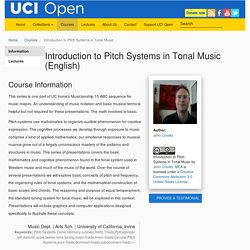
An understanding of music notation and basic musical terms is helpful but not required for these presentations. The math involved is basic. Pitch systems use mathematics to organize audible phenomenon for creative expression.
Learning by Doing: An Introduction - Music Theory for Digital Audio Workstation - OpenStax CNX. Introduction to Pitch Notation in Music - Music Fundamentals 1: Pitch and Major Scales and Keys - OpenStax CNX. OpenStax CNX. OpenStax CNX. How to Read Music Note Values. Reading music notes means understanding the value of each note (that is, how long each note lasts) and how notes fit together in sheet music.
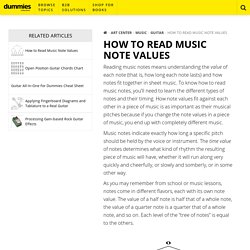
To know how to read music notes, you’ll need to learn the different types of notes and their timing. How note values fit against each other in a piece of music is as important as their musical pitches because if you change the note values in a piece of music, you end up with completely different music. Music notes indicate exactly how long a specific pitch should be held by the voice or instrument. The time value of notes determines what kind of rhythm the resulting piece of music will have, whether it will run along very quickly and cheerfully, or slowly and somberly, or in some other way. As you may remember from school or music lessons, notes come in different flavors, each with its own note value. Lecture 4. Rhythm: Jazz, Pop and Classical. Linear Theory, Lesson One: The Staff.
Score Reading. Open Exploring Theory Textbook. Music Theory. Skip to content Find Me Elsewhere.

Chord Progression in Tonal Music. Following is a summary of Syntactic Structures in Music.
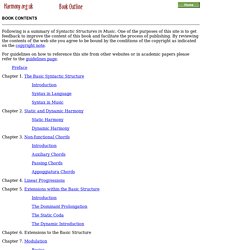
One of the purposes of this site is to get feedback to improve the content of this book and facilitate the process of publishing. By reviewing the contents of the web site you agree to be bound by the conditions of the copyright as indicated on the copyright note. For guidelines on how to reference this site from other websites or in academic papers please refer to the guidelines page. Preface. An introduction to music theory - OpenLearn - Open University - A224_1.
Teoria - Tutorials. Music Theory Q & A.
Justin Rubin Theory and Composition Resources. All materials are protected under copyright © Justin Henry Rubin 2011 Institutions or individuals interested in the pedagogical materials of Justin Henry Rubin are encouraged to contact the author.
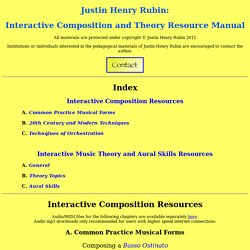
Interactive Composition Resources A. Common Practice Musical Forms B. 20th Century and Modern Techniques C.
Music Theory Online. Music Theory Worksheets. Jazz Theory. Counterpoint. A Feeling for Harmony Book 3 Home page. Syllabus 2014 Chapter 1: Review of Foundational Materials Introduction (re-write) 1A Pythagorean thought (re-write) 1B Harmonic Ratios 1C Pythagorean Comma 1D Pythagorean Intonation 1E Just Intonation 1F Synthonic Comma 1G Harmonic Series 1H Harmonic Polarity Chapter 2: Principles of extended common practice tonality 2A Diatonic Harmony and Mixed Modes 2B Chromaticism I: Secondary Dominants 2C Chromaticism 2: Aug 6 and N6 as cadential pre-dominants 2D Chromaticism 3: Expanded Mediants 2E "Any chord can follow any other chord.
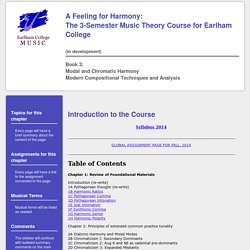
" 2F Extended tonality in contemporary tonal composition (including progressive types of Rock). Chapter 3: The practice of part writing based on the mixed-mode technique Chapter 4: The language of "Impressionism"; its imitation in film score, and its influence on jazz harmony. Chapter 5: Extended tonality in 20th Century Composition Stravinsky Bartok Messiaen Shostakovich Latin American Classical Composers. Feeling for Harmony Book 2 Home. A Feeling for Harmony: The 3-Semester Music Theory Course for Earlham College (in development)

Feeling For Harmony Book 1 Home Page. Course Syllabus, 2012 Chapter 1: Foundational Materials for the Study of Western Music Theory 1A Pitch 1B Staff Symmetry and Note Names 1C Meter and Rhythm 1D Metric Examples 1E Pentatonic Scales 1F Pentatonic Tunes 1G Recognizing Intervals in Staff Notation 1H Key Signatures and the Circle of Fifths 1I The 6 basic modes of Western music 1J Understanding the major and minor scale 1K Singing with solfege: fixed and movable Do 1L Introducing Pythagoras, the musician IM Music Math 1: Ratios and Commas, part 1 IN Music Math 1, continued: Pythagorean Comma and the Circle of Fifths Chapter 2: Beginning Composition: Melody Writing and Counterpoint2A The relationship of meter and poetic text 2B Setting a text to a modal melody Interlude: Guide to identifying intervals by ear Chapter 3: Fundamentals of Harmony and Part Writing. 1.

Chapter 4: Putting it Together 6A The Bach Chorale and the St. Engaging Students: Essays in Music Pedagogy. Engaging Students: Essays in Music Pedagogy presents short essays on the subject of student-centered learning, and serves as an open-access, web-based resource for those teaching college-level classes in music.
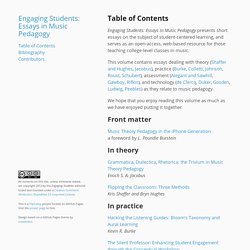
This volume contains essays dealing with theory (Shaffer and Hughes, Jacobus), practice (Burke, Colletti, Johnson, Roust, Schubert), assessment (Alegant and Sawhill, Gawboy, Rifkin), and technology (de Clercq, Duker, Gosden, Ludwig, Peebles) as they relate to music pedagogy. We hope that you enjoy reading this volume as much as we have enjoyed putting it together.
Front matter. Online Music Theory Flashcards with Audio. Description Imagine DRAMATICALLY improving your music theory knowledge FASTER than you ever thought possible! With over 8,000 Flashcards at your fingertips, this is the quickest and most effective music theory app available for studying piano, voice, guitar, band instruments, and more -- no matter what music theory class or textbook you may be using. Learn Music Theory Faster. IMSLP448052 PMLP547603 danhauser theorie lemoine. Music. USC Thornton School of Music. USC Thornton School of Music. This examination tests general knowledge and skills in the area of music theory and analysis.The actual examination must be completed in 90 minutes and will be graded with PASS or FAIL. General Study Suggestions Kostka, Stephan and Dorothy Payne. Tonal Harmony: With an Introduction to Twentieth-Century Music. 7th edition.
McGraw-Hill, 2012. There is an accompanying workbook that could prove helpful in preparing for the exam, and includes 2 CD’s worth of audio recordings of the musical examples in the workbook. In multiple-choice questions, there may be more than one correct answer. Error Detection: Questions 1-5 refer to the example below. Example A. 6. Example B. 7. Example C. 8. 9. Example D. How to Read Music - Episode 4: Counting and Clapping. Rhythm Notation - The basics of reading music. Quiz: would you have passed GCSE Music? 25 August 2016, 08:50 We've taken some questions from a 2013 GCSE Music exam paper - what grade do you think you'd get? Would you even pass? Time to find out… All those hours spent revising Italian musical terms, tempo markings and key signatures has come down to this - can you still cut the mustard when it comes to GCSE Music?
GCSE Music too easy? We've taken some questions from an AQA Music GCSE exam paper from 2013 (you can find it here) and put them in a neat little quiz that'll tell you if you'd still manage to pass. DISCLAIMER: this probably isn't a great tool for revision and will definitely not guarantee you passing any forthcoming exams. GCSE Music - Bach Class Clips. Music Theory Lessons - Notes and note values. How to Read Sheet Music: Step-by-Step Instructions. Have you ever heard a song on the radio and thought, “Hey, it’d be really cool to know how to play that.”?
Do you have friends who play musical instruments, and you want to get in on the fun? Do you just want to expand your general artistic knowledge? Well, learning the basics of how to read sheet music can help you achieve all of these, and in a shorter amount of time than you might have thought! Musical Words Quiz: Weekly Challenge. Hathi Trust Digital Library. Hathi Trust Digital Library. HathiTrust Digital Library. Hathi Trust Digital Library. Hathi Trust Digital Library.
Music Theory – Collections – Google+ Music Theory - Grades 1-5. David E. Farrell. Major scales at DuckDuckGo. Minor scales Topics at DuckDuckGo. Online theory. Music Theory - Raccolte. The Ultimate List of Online Music Education Games. Having a background as a music teacher, I often get the asked what resources are available for homeschoolers to grow in their music studies.
As such, today I’d like to share with you an Ultimate List of Online Music Education Games available for FREE to public and homeschoolers alike to have fun while learning more about music. Whether playing via iPad, SmartBoard, or laptop, each resource provides supportive games and activities to reinforce music concepts at home. For your browsing convenience, these online music education games are organized into the following categories: aural training, composers, composition, instruments, notation, symbols/vocabulary and variety. Aural Training Composers. Understanding Basic Music Theory - Free online course. Understanding Basic Music Theory is a comprehensive insight into the fundamental notions of music theory: music notation, rules of harmony, ear training, etc.
It covers most of the topics needed to understand and develop your musical skills - with your favorite training tool EarMaster of course! This fantastic mine of information was written by Catherine Schmidt-Jones et al. and originally published on OpenStax CNX. Course Introduction. Glossary of musical terminology. This is a list of musical terms that are likely to be encountered in printed scores, music reviews, and program notes. Most of the terms are Italian (see also Italian musical terms used in English), in accordance with the Italian origins of many European musical conventions.
LilyPond Tutorial 1 - Introduction & First Score. Music Theory - Understanding Intervals: Part 2. Music Theory: Note Names, Rests & Dotted Notes. Music Theory: Note Names, Rests & Dotted Notes. Harmony practice 3. Simple entry positioning:set the current voice - bass, tenor, alto, soprano, then select a note, or rest, and click a position in the score. Should the entry result incorrect, keep the mouse button down, or click the entry again, and drag it to the desired location. Alternatively, select the repitch tool (an orange coloured arrow in the Accessory tools palette) and perform dragging.
Simple entry erasing: set the current voice - bass, tenor, alto, soprano, then right click an entry, select Delete item from the fast menu. Alternatively, use the eraser tool (from the Accessory tools palette). 'Basic Theory' in Music. Sound Properties (Amplitude, Period, Frequency, Wavelength) Chesnokov Op. 40-5 "Do not cast me off" (Concerto for bass profondo and choir) Music Theory for Musicians and Normal People. By Toby W. Rush This page includes links to each of the individual Music Theory pages I've created in PDF form. This is a work in progress; I am writing new ones regularly and fixing errors and omissions on existing ones as I find them.
If you find them useful for your theory studies, you are welcome to use them, and if you find errors or have suggestions, I invite you to contact me. LilyPond – Music notation for everyone: LilyPond... music notation for everyone. Free and Open Music Notation Editor. Online Music Notation Software. Free music composition and notation software.
6 Open Source Software Projects of (Musical) Notation. As it's been pointed out before, there seems to be a sizable overlap between open source hardware and software enthusiasts and amateur musicians. Glossary of Musical Terms. Sight-reading. Caravaggio's Rest on the Flight into Egypt (1594–96) Score-Reading. 'Score Reading' in Music. SOUND PATTERNS Table of Contents. Chord (music) Mussorgsky's Pictures at an Exhibition "Promenade", is a piece showing an explicit chord progression. (Nattiez 1990, p. 218) Play In the medieval era, early Christian hymns featured organum (which used the simultaneous perfect intervals of a fourth, a fifth, and an octave[13]), with chord progressions and harmony an incidental result of the emphasis on melodic lines during the medieval and then Renaissance (15-17th centuries).[7][14] The Romantic period, the 19th century, featured increased chromaticism.[7] Composers began to use secondary dominants in the Baroque, and they became common in the Romantic period.[19] Many contemporary popular Western genres continue to rely on simple diatonic harmony, though far from universally:[20] notable exceptions include the music of film scores, which often use chromatic, atonal or post-tonal harmony, and modern jazz (especially circa 1960), in which chords may include up to seven notes (and occasionally more).[21]
Polychord. Quartal and quintal harmony. Four note quartal chord Play . Scale (music) Pattern of intervals in the C-major scale. ReadingMusic. Download an educational game for music education. Virtual Piano : The original app. Tom Pankhurst's Guide to Schenkerian Analysis - Home Page. Music Theory Introduction. Music 101: Intro to Music Course. Understanding Basic Music Theory: Course Introduction. Introduction to Music Theory. Online Music Theory Flash Cards.